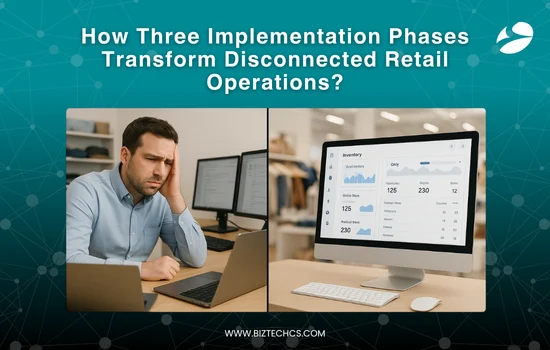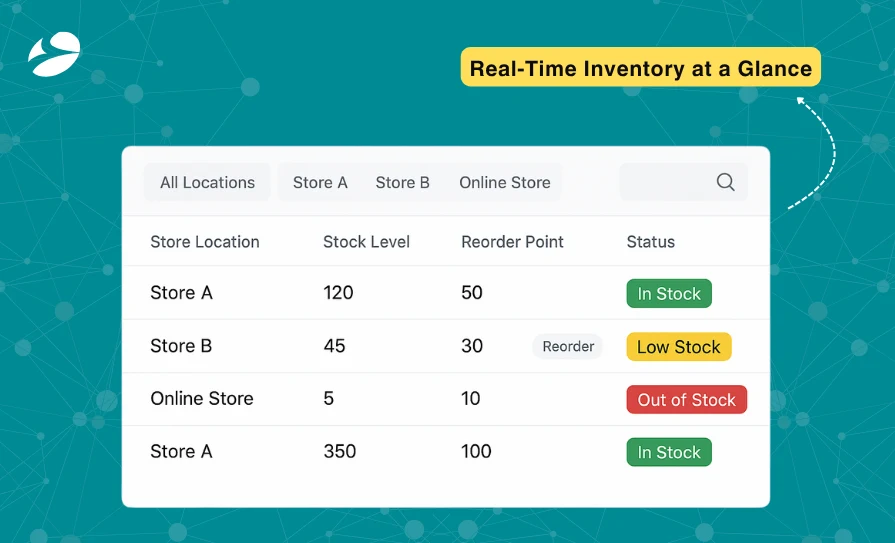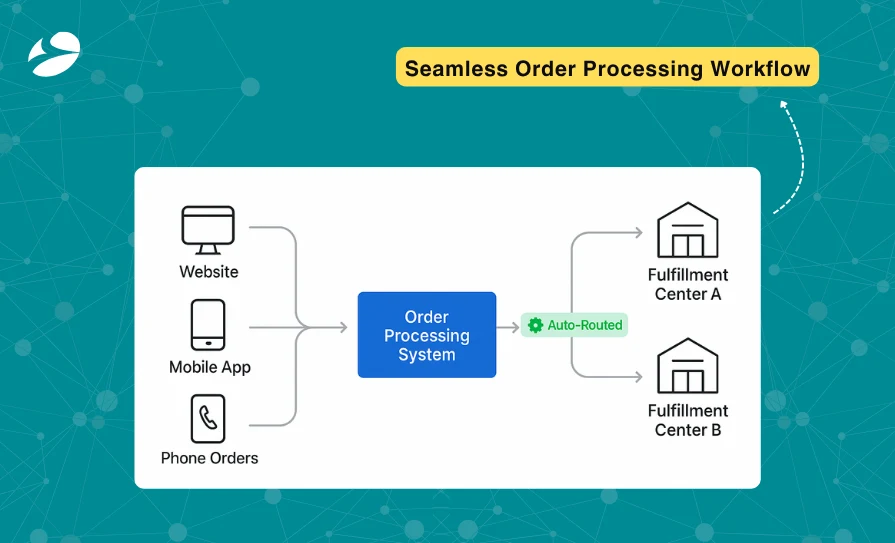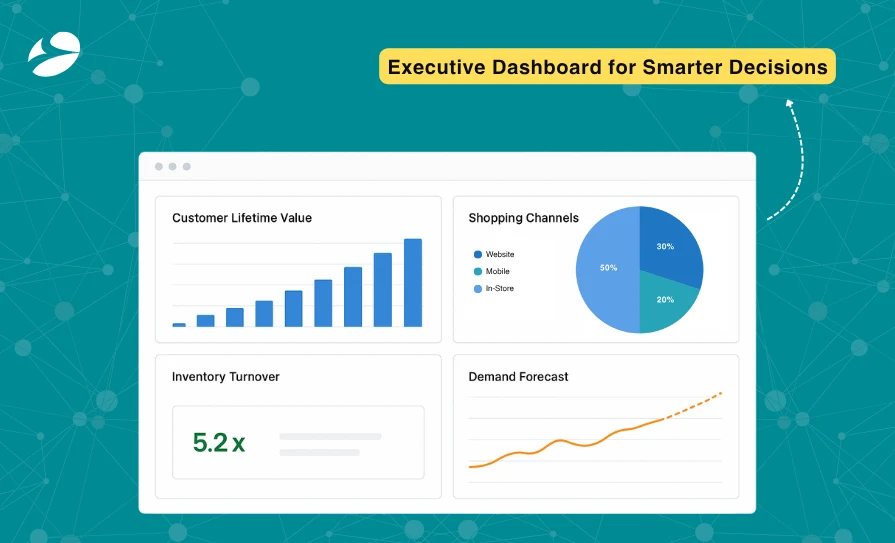What Role Centralized Inventory Management with Odoo can Play in UAE Retail Growth?
01 Oct, 2025
5 min read
01 Oct, 2025
5 min read

The UAE’s retail landscape is undergoing a seismic shift. As part of the ‘We the UAE 2031’ vision, the nation is positioning itself as a global retail powerhouse. This strategic initiative aims to double the country’s GDP, boost non-oil exports, and enhance the tourism sector’s contribution to the economy (UAE Government Portal).
Central to this transformation is the integration of advanced technologies and the development of robust digital infrastructures.
However, as UAE retailers embrace this digital evolution, many encounter a significant hurdle: fragmented and siloed systems. These disconnected platforms often lead to operational inefficiencies, such as inconsistent stock levels across channels and delayed order processing.
For instance, a customer might place an online order, only for a fulfillment manager to manually check stock availability and discover the item is out of stock. Meanwhile, the online store continues to accept orders for inventory that is no longer available.
This scenario underscores the critical need for a centralized system that provides real-time updates on stock availability. Implementing solutions like Odoo for omnichannel retail can address these challenges by synchronizing inventory data across all sales channels, automating stock level management, and enabling multi-location visibility.
Such integration ensures that retailers can meet customer expectations for seamless shopping experiences, aligning with the UAE’s vision of becoming a global retail leader by 2031.
Research shows that 75% of customers (businesses!) expect consistent experiences across all channels, yet only 28% of B2C companies manage to deliver on this expectation (Salesforce). This gap isn’t just about customer satisfaction—it’s hitting the bottom line hard. Retailers using multiple disconnected systems for managing inventory and sales struggle with data fragmentation.
A common issue is when a retail chain uses separate inventory systems for physical stores and online platforms. This results in mismatched stock levels across channels, requiring manual reconciliation every morning.
These inconsistencies frustrate customers and lead to abandoned online carts, even when the product is in-store. Without a centralized system providing real-time stock updates, retailers miss sales opportunities and increase inefficiencies.
Working with retailers facing these issues, we often ask: ‘How many systems does your team use daily to get a clear picture of inventory and sales performance?’ This question uncovers the complexity and inefficiency of fragmented systems that hinder productivity.
Executives often ask: ‘Is technology the problem, or is it how teams are forced to adapt to fragmented systems?’ The answer is both. Technology creates operational silos, which then evolve into major obstacles to efficient decision-making.
Teams lack real-time access to inventory, outdated customer service data breeds frustration, and managers don’t have a unified view to make informed, strategic decisions.
If this sounds familiar in your retail operations, it may be time to adopt a more integrated approach to your business. Centralized inventory management with Odoo can significantly improve visibility and streamline your operations.
Noticing these hidden inefficiencies in your retail operations? This is usually the first sign it’s time to integrate.
The term ‘omnichannel’ is widely discussed, but how does it impact your retail operations? At its core, omnichannel retail is about creating a seamless customer experience across all touchpoints, both online and in-store.
Retailers who embrace a strong omnichannel strategy gain significant benefits—studies show that those with solid omnichannel engagement retain 89% of customers, compared to just 33% for those with weaker strategies (UniformMarket). Centralizing inventory and sales processes with tools like Odoo for omnichannel retail boosts customer satisfaction and ensures consistency across all channels.
When working with retailers facing these challenges, we often hear similar frustrations:
These operational pain points translate directly into customer experience issues. A customer might drive to your store based on online inventory information, only to discover that the item is unavailable. Or they might wait weeks for an item that’s actually sitting in a store location just miles away.
During our discovery sessions, we often ask clients: How often do you currently experience situations where customers are unable to complete their desired transaction due to system limitations or inventory discrepancies? This question usually reveals the frequency and cost of these missed opportunities.
The path to seamless retail operations begins with your inventory system—the heart of customer experience. BiztechCS often begins by implementing centralized inventory management using Odoo. This centralization transforms how stock is tracked and optimized across all locations and sales channels.

Rather than expecting an immediate shift, we take a phased approach to gradually implement real-time stock updates with Odoo, ensuring smooth business continuity throughout the process. The first phase focuses on:
Centralizing the inventory system eliminates the need for manual stock checks and reconciliations, providing your team with real-time updates.
Odoo Consultation Tip: Before centralizing your inventory, schedule a consultation focused on data migration and process alignment. This session helps identify which data needs cleansing, which stock locations require prioritization, and how staff should be trained for real-world usage. Many retailers find that involving floor staff during this consultation not only enhances system accuracy but also fosters ownership, ensuring a smoother adoption once the system goes live.
Naturally, retail leaders ask: “But how do we make sure this transition doesn’t disrupt day-to-day operations?” This is where the phased approach proves critical. By starting small with a pilot, focused on specific locations or product lines, we ensure minimal disruption. Staff remain engaged, business continues smoothly, and the rollout scales at a manageable pace.
Many retailers are concerned about the challenges of moving from fragmented systems to a unified platform. However, with thoughtful Odoo retail integration for physical and online stores, the complexity of data silos can be reduced, simplifying daily operations rather than adding new complications.
Starting Small, Scaling Smart
Rather than implementing a full-scale integration across all locations and product lines from day one, we often recommend starting with a pilot program. This allows you to focus on your highest-volume products or the most problematic inventory categories, refining processes before scaling the system across the entire business.
Staff Engagement and Training
Your team’s adoption of the new system determines its success. We involve staff in identifying pain points and desired features, creating natural champions who help drive organization-wide adoption.
Could your business benefit from a pilot rollout to test integration before full-scale implementation? It’s often the safest approach.
Once your inventory system is in place, we integrate your sales channels. The Odoo sales module for retail and e-commerce streamlines order management, delivering a smooth experience for both customers and operational teams. This integration ensures that orders from both online and physical stores are processed through a single system, eliminating confusion and improving efficiency.

When we implement integrated sales systems, customers can place orders through any channel—whether browsing your website, visiting your store, or calling your customer service team—and all orders are processed through the same underlying system. This integration eliminates the confusion and delays that occur when different channels operate independently.
Single Order Management Dashboard
We provide your team with access to all orders through a single interface, regardless of how customers place them. This unified view enables better prioritization, more efficient fulfillment, and consistent communication with customers about order status.
Automated Fulfillment Routing
Our system intelligently determines the optimal fulfillment location for each order, taking into account inventory availability, customer location, and shipping preferences. An online order might be fulfilled from the nearest store, while an in-store purchase could trigger automatic replenishment from your central warehouse.
Cross-Channel Customer Service
We ensure your customer service team can access complete order history and current status information, regardless of how customers initially placed their orders. This comprehensive view enables more helpful, informed customer interactions.
By implementing Odoo POS with real-time inventory tracking and queue management, a supermarket reduced checkout times by 35%, improving customer experience and reducing friction at the point of sale (DIS Saudi Arabia).
Real-Time Order Tracking
Our system ensures customers receive consistent, accurate updates on their orders, whether placed online or in-store. Automated notifications at key fulfillment stages reduce customer service inquiries and boost satisfaction.
Flexible Fulfillment Options
Our integration enables creative fulfillment options, such as buy-online-pickup-in-store (BOPIS), ship-to-store, or same-day delivery from local inventory. These options cater to diverse customer preferences while optimizing operational efficiency.
Returns and Exchanges Simplified
Customers can return or exchange items at any location, regardless of where they were purchased. Your staff gets immediate access to purchase history, streamlining the returns process and enhancing customer experience.
During this phase, we often ask our clients: How much time does your team currently spend tracking down order information across different systems, and what would they focus on instead if this process were automated? The answers help us fine-tune the system to maximize productivity gains.
It’s also common for operations directors to raise the concern: “Will integrated sales channels really help us manage complex promotions across both online and offline without errors?” The answer is yes—unified order management ensures consistency. Whether it’s a seasonal online sale, a buy-one-get-one deal in-store, or loyalty rewards across both, the system manages rules centrally. This prevents pricing mismatches, strengthens customer trust, and ensures accurate financial records.
Odoo Consultant Tip: Before rolling out integrated sales channels, schedule a consultation session to audit your pricing rules, tax setups, and promotional structures across all platforms. This proactive step helps ensure consistency, prevents customer-facing errors, and reduces the risk of revenue leakage. Retailers who take this approach find it easier to launch campaigns confidently, knowing their online and offline channels are aligned from the start.
The final phase focuses on leveraging your integrated data to drive strategic decisions and deliver personalized customer experiences. Once your inventory and sales systems are fully integrated, you gain unparalleled visibility into both customer behavior and overall business performance.

By consolidating cross-channel purchase data, your system creates detailed customer profiles, allowing your team to deliver more personalized and targeted experiences both online and in-store.
Behavioral Analytics and Insights Our implementation helps you understand how customers move between channels, providing valuable insights for inventory planning, marketing campaigns, and customer service strategies. You may find that customers who browse online but make in-store purchases have different preferences from those who are purely online shoppers.
Personalized Experience Delivery With comprehensive customer data in place, your team can provide personalized recommendations, targeted promotions, and customized service based on individual customer history and preferences.
Real-Time Performance Monitoring: We provide dashboards that offer instant access to key performance indicators across all channels and locations, enabling you to identify trends, spot issues early, and act on opportunities.
Inventory Optimization Our system combines historical sales data with seasonal trends and current inventory levels to enable more accurate demand forecasting and inventory planning. This intelligence helps reduce carrying costs while ensuring product availability.
Strategic Planning Support We provide comprehensive reports to support strategic decisions about new locations, product lines, pricing strategies, and resource allocation, all based on real performance data.
When we reach this phase, we often ask clients: What decisions would you make differently if you had real-time visibility into customer behavior and performance metrics across all your sales channels? This question enables us to tailor the analytics and reporting features to support your specific strategic objectives.
At this stage, C-level leaders often wonder: “Can analytics go beyond reporting and actually help us make predictive decisions?” The answer is yes. With Odoo’s analytics layer, you move from backward-looking reports to forward-looking predictions. For example, by analyzing seasonal buying patterns and local demand signals, the system can recommend optimal stock allocations or trigger marketing campaigns before demand spikes.
Odoo Consultant Tip: Map how customer data flows across all channels before unifying it in Odoo. Standardize fields and clean duplicates to avoid reporting gaps. Configure role-based dashboards during setup so each team gets the insights they need. This ensures real-time, actionable analytics from the first day of use.
Success goes beyond operational efficiency—it directly affects your bottom line and customer relationships. We’ve observed that businesses that successfully implement omnichannel retail strategies typically see measurable improvements across multiple areas.
Revenue Growth Through Better Availability
When we implement systems that provide customers with confidence in product availability, conversion rates improve dramatically. Our clients typically see 15-25% increases in online conversion rates simply by providing accurate, real-time inventory information.
Reduced Operational Costs
Automated inventory management and unified order processing reduce the manual labor currently required to maintain separate systems. Staff time previously spent on data reconciliation can be redirected to customer service and strategic activities.
Optimized Inventory Investment
Better demand visibility and automated reordering through our implementations help optimize inventory levels, reducing both stockouts and excess inventory carrying costs. Many BiztechCS clients reduce inventory investment by 10-20% while improving product availability.
Improved Satisfaction Scores
Customers appreciate consistent experiences and accurate information. Net Promoter Scores typically improve when omnichannel strategies are successfully implemented, as customer frustration with system limitations decreases.
Increased Customer Lifetime Value
Omnichannel customers typically spend more over time compared to single-channel customers. When we make it easy for customers to interact with your business through their preferred channels, they tend to engage more frequently and make larger purchases.
Enhanced Brand Loyalty
Consistent, reliable experiences across all touchpoints build customer confidence in your brand. This trust translates into repeat purchases and positive word-of-mouth recommendations.
Faster Decision Making
With real-time data from BiztechCS, your team can quickly respond to market changes, inventory issues, and customer needs, addressing problems before they impact operations.
Improved Staff Productivity
With access to accurate, up-to-date information, your staff can serve customers more effectively and spend less time hunting for data across systems.
Better Resource Allocation
Comprehensive visibility into performance across all channels enables more strategic allocation of resources, whether for inventory, staffing, or marketing investments.
During our success measurement phase, BiztechCS asks: ‘Which of these improvements would most impact your business challenges, and how will you measure success in your specific situation?’ This helps us set benchmarks and track progress.
Could smarter allocation of staff, stock, and marketing budgets unlock growth potential in your business? The insights are already in your data.
Every retail business faces unique hurdles when moving from fragmented systems to integrated operations. We have strategies in place to address these challenges and ensure a smoother implementation.
Legacy System Compatibility
Many retailers worry about integrating existing systems with new omnichannel capabilities. We specialize in working with your existing infrastructure through APIs and data synchronization, enabling gradual migration instead of full system replacement.
Data Migration and Quality
Transitioning to a unified platform requires careful attention to data quality. We focus on clean, accurate data migration, ensuring a solid foundation for system success.
Staff Training and Adoption
Technology changes can create anxiety among staff accustomed to existing processes. We prioritize thorough training and ongoing support to ensure your team is confident in using new systems.
Phased Implementation Approach
Rather than making changes all at once, we employ a phased approach that allows teams to adapt gradually while maintaining business continuity.
Clear Communication and Expectations
We keep stakeholders informed about progress, benefits, and any temporary disruptions to maintain support and enthusiasm.
Continuous Improvement Mindset
We see go-live as the start of an ongoing optimization journey. Regular system refinements based on user feedback and data help maximize long-term value.
When addressing concerns, we often ask: ‘What concerns do you have about implementing integrated retail systems, and how can addressing these early ensure success?’ This helps us tailor our approach.
Odoo Consultant Tip: Before starting an implementation, schedule a consultation session to map your current workflows against Odoo’s capabilities. This step helps uncover hidden bottlenecks, identify quick wins, and set realistic expectations for your team. Many businesses find that this early consultation not only clarifies priorities but also builds alignment among stakeholders—making the transition smoother and more effective.
Moving from fragmented retail operations to seamless omnichannel experiences takes time, but it doesn’t have to be overwhelming. Success comes from thoughtful, strategic steps that build on your strengths and address pressing challenges.
Current State Analysis: We start by understanding your existing systems, processes, and pain points, laying the foundation for effective planning. This analysis identifies integrations that will deliver immediate value and helps prioritize phases.
Future State Vision: We collaborate with you to define clear outcomes—whether improving customer experience, operational efficiency, or driving business growth—guiding decisions and tracking progress throughout the implementation.
Successful resource planning requires adequate time, budget, and staff. Our realistic planning prevents rushed decisions, ensuring your team can support the transition effectively.
Stakeholder Engagement
We engage key team members in planning and decisions, fostering ownership and ensuring the solution meets operational needs. Front-line staff provide insights into customer pain points and workflow needs.
Ongoing Support and Optimization
We offer implementation expertise and a proven track record of successful omnichannel projects. We understand your challenges and provide ongoing support after implementation.
Success Metrics Definition
We set clear, measurable goals to track progress and show value during implementation. These metrics align with business objectives and provide actionable insights for continuous improvement.
When planning your path forward, we ask: ‘Are you ready to take the first step toward unified retail operations?’ BiztechCS would be happy to discuss how an integrated approach can address your challenges and support your growth.
The retail landscape continues to evolve rapidly, with customer expectations for seamless experiences rising alongside technological advancements. Businesses that successfully integrate their operations position themselves not just to meet current customer demands, but to adapt quickly to future market changes.
Odoo for omnichannel retail provides the foundation for this transformation, but technology alone doesn’t guarantee success. We combine robust technical capabilities with careful change management, comprehensive staff training, and ongoing optimization based on real-world performance data.
Your journey toward integrated retail operations represents more than a technology upgrade—it’s an investment in your business’s long-term competitiveness and growth potential. By eliminating inefficiencies and customer frustrations caused by fragmented systems, we create space for innovation, enhanced customer relationships, and strategic growth initiatives.
The question isn’t whether omnichannel retail integration will benefit your business, but how quickly we can implement these capabilities while maintaining operational stability. Every day spent managing disconnected systems is a day not spent serving customers, growing sales, and building competitive advantages.
Whether you’re just beginning to explore omnichannel possibilities or ready to move forward with implementation, we provide actionable steps that align with your current situation and growth objectives.
Consider scheduling a consultation with BiztechCS to discuss your specific challenges and explore how integrated retail operations might address your pain points while supporting your business goals. There’s no obligation—just an opportunity to gain clarity about your options and potential next steps.
Ready to take the first step toward omnichannel success? Let’s explore how we can turn your challenges into growth opportunities together.

Odoo
101
By Uttam Jain
13 Nov, 2025

Artificial Intelligence (AI)
293
By Afzal Qureshi
28 Oct, 2025

Odoo
175
By Uttam Jain
28 Oct, 2025